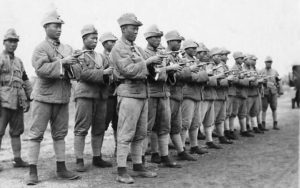Sabillasville Caught up in Chinese Civil War
by James Rada, Jr.
Once Marion Firor left Thurmont on the express train on August 20, 1916, it took her more than a month to reach China, where she was to become a missionary teacher. She fell in love with the country and the people there, only to see it ripped apart by war.
She received word of her appointment at the Yochow School in Yochow, China, a city of about 40,000 people, on April 27 and began making preparations for her departure. She had to resign from her teaching position at Boonsboro High School where she taught English.
Her father was the reverend at St. John’s Reformed Church in Sabillasville. He held a farewell service for his daughter at the church on August 10.
She enjoyed her work at the school and loved the children, but tensions were brewing in the country. She wrote her family regularly, although it took the letters just as long to reach her family as it had taken Marion to reach China.
She wrote that many of the buildings in Yochow were made of gray brick and ranged from one to three stories tall. Although foreigners worked in the city, there was still some xenophobic sentiment among the people.
“Yochow was one of the last cities of China to admit foreigners, and they are still looked upon askance by some,” Marion wrote.
Still, she loved the Chinese people and admired their ability to endure. “Calamities that would crush foreigners seem never to faze them. It is nothing unusual for a merchant owning a stand to have his business totally destroyed several times by the frequent fires or looted by soldiers. Yet, he begins again at the bottom only to have his work once more undone,” she wrote.
In early April 1918, the Firors received a cable that read “Yochow in ashes—Missionaries safe—women gone from the city.”
Fighting had broken out in China among various factions. Her family was anxious over whether Marion had remained safe or not as they waited for further word from her and read news reports of the fighting.
The fighting moved away from Yochow, and Marion returned to the school and resumed teaching.
Then, in late June of 1920, word reached the Firors that soldiers had murdered Rev. W. A. Reimert in Yochow. This was someone Marion knew and worked with on occasion. The Firors once again grew anxious over the safety of their daughter.
They received a letter from Marion in early August that had been written a few days before her parents had heard of Rev. Reimert’s murder. She was in Chinkungahan and wrote of people fleeing the city on a sailboat flying the American flag.
“Chinese teachers’ houses had been looted; our girls who lived there and some of their friends had been stripped of all but their inner garment and searched for money, and Mr. Reimert had been shot and instantly killed,” Marion wrote.
Friends snuck people out of the city at night and many of them fled to the missionary school. International law allowed the school to protect women and children, but not men.
Food became scarce. Fires started in various areas of the city from the fighting. Soldiers occupied whatever homes they wanted and dug up the floors of homes looking for hidden valuables. Marion also wrote that Rev. Reimert had been shot trying to keep soldiers out of the school.
The school was only a temporary sanctuary, though. It soon became obvious that it would either burn or be raided, so the teachers, students, and refugees started to flee.
“So, we flung a few things in our trunks preparatory to leaving. But, mother, it was terrible to have people come and hang onto you and beg you to save their lives. In the same breath they begged us to stay and to go and take them,” Marion wrote.
She managed to escape from the city, but she realized in her haste to flee she had taken a lot of unnecessary items and left behind needed ones.
“You find you have parts of several dresses and no whole ones, no pencils or pins or any of the little things one needs, one washrag and towel which you have to keep washing every day, and all sorts of crazy things you don’t need and so few of those you do,” she wrote.
Things calmed down once again, school resumed, and things began to look normal. She said she tried to focus on the mundane and the classes she taught in biology, chemistry, bacteriology, and English.
In 1921, she made plans to return home by the fall. However, there were still intermittent troubles in her region of China. Soldiers entered a home of one of Marion’s day school pupils. The soldier started to carry off a table. “The mother objected too strenuously to suit them, so they put the table down and took the woman instead,” Marion wrote.
They were also stealing supplies from the school, but no one dared object.
In July, she sailed on the Empress of Asia to Vancouver, British Columbia. She arrived on August 9. It then took another week before she reached home.
Leaving China had been more treacherous than she expected, as the group encountered various groups of soldiers. She had also been robbed when a crook cut a hole in her suitcase and stole $90.
She had been home less than a month when she told her father’s congregation, “The country fairly seems to get into your blood. You hate to leave it. I have really been homesick for it since my return.”


